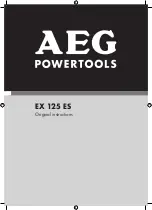
English
6
Accessories
WARNING:
Since accessories, other than those
offered by CRAFTSMAN,
have not been tested with
this product, use of such accessories with this tool
could be hazardous. To reduce the risk of injury, only
Cleaning
WARNING:
Blow dirt and dust out of all air vents with
clean, dry air at least once a week. To minimize the risk
of eye injury, always wear ANSI Z87.1 approved eye
protection when performing this procedure.
WARNING:
Never use solvents or other harsh
chemicals for cleaning the non-metallic parts of
the tool. These chemicals may weaken the plastic
materials used in these parts. Use a cloth dampened
only with water and mild soap. Never let any liquid
get inside the tool; never immerse any part of the tool
into a liquid.
MAINTENANCE
WARNING: To reduce the risk of serious personal
injury, turn unit off and disconnect it from
power source before making any adjustments or
removing/installing attachments or accessories.
An accidental start-up can cause injury.
Sanding
WARNING:
Let the tool work at its own pace.
Do
not overload.
Grasp the sander and turn it ON. Move it in long, sweeping
strokes along the surface, letting it do the work.
• Secure the workpiece to prevent it from moving.
Friction between the sanding disc and the workpiece
can spin the workpiece away from sander and may
cause bodily injury.
• Pushing down on the tool while sanding actually slows
the removal rate and produces an inferior quality finish.
• Check your work often. This sander is capable of
removing material rapidly.
the car before power polishing it. Washing will remove
loose dirt, scum, road salt, etc. which could act as an
abrasive and damage paint. Loose dirt, etc. will also
clog the polishing pad and you will have to clean it
more often.
• Without turning the tool on, grasp the handles of the
tool and pick it up (Fig. E). Keep the tool away from your
body and depress the trigger switch. Make sure you
have a firm grip on the handles and operate the tool
freely without forced effort or unnecessary pressure. The
side handle can be easily changed to either side of the
tool for left-handed or right-handed operation.
nOTE:
The high speed rubbing action of the polishing
bonnet upon the surface of an automobile can build a
static charge on the metal portions of this tool. This can
result in a sensation of a very short mild electric shock
when the metal area of the tool is touched, and will be
more noticeable on days when the humidity is low. This is a
harmless phenomenon.
Polishing
These instructions and suggestions are intended to
familiarize new operators in overall general operation of
power polishing. You will develop your own techniques
which will make the job easier and faster as you learn
power polishing.
• You should use utmost care when power polishing
around or over sharp objects and contours of the car
body. It is very important to use the correct pressure
while polishing various sections of an automobile body.
For example, light pressure should be applied when
polishing over sharp edges of body panels, or over
edges of the rain gutter along the top.
• Since everyone does not use the same type of power
polish, we recommend you clean and polish a test
section on a flat area of the car first. From this test
section, you can judge the strength or cleaning action of
your power polish.
• Remember, all power polish is not the same. Different
brands will react differently on various painted surfaces.
Also, you are now using a rotary polisher with power
polish which is entirely different from any hand
application which you may have done before. Wash
Proper Hand Position (Fig. E)
WARNING:
To reduce the risk of serious personal
injury,
ALWAYS
use proper hand position as shown.
WARNING:
To reduce the risk of serious personal
injury,
ALWAYS
hold securely in anticipation of a
sudden reaction.
Proper hand position requires one hand on the auxiliary
handle
3
and one hand on the main handle
6
.
OPERATION
WARNING: To reduce the risk of serious personal
injury, turn unit off and disconnect it from
power source before making any adjustments or
removing/installing attachments or accessories.
An accidental start-up can cause injury.
Attaching Accesory (Fig. D)
WARNING:
To reduce the risk of serious personal
injury, do not allow any loose portion of the polishing
bonnet or its attachment strings to spin freely. Tuck
away or trim any loose attachment strings.
Loose and
spinning attachment strings can entangle your fingers
or snag on the workpiece.
Polishing pads and abrasive discs with a diameter of 6"
(25 mm) may be used with the CMEE145.
1. To attach an accesory
5
, carefully center it over the
backing pad
4
ensuring the edges of the disc align with
the edges of the pad and press the disc firmly in place.
2. The accesory can be easily removed by simply pulling it
off. It can be reused as desired.
Be sure to select the proper speed for your tool operation. If
in doubt about the proper speed for your operation, test the
performance at low speed settings and gradually increase
until a comfortable speed is found.
Summary of Contents for CMEE145
Page 3: ...1 Fig C 2 Fig D 5 4 Fig E 3 6 ...
Page 25: ......
Page 26: ......
Page 27: ......
Page 28: ...10 19 Part No N778763 CRAFTSMAN 701 East Joppa Road Towson MD 21286 Copyright 2019 ...









































